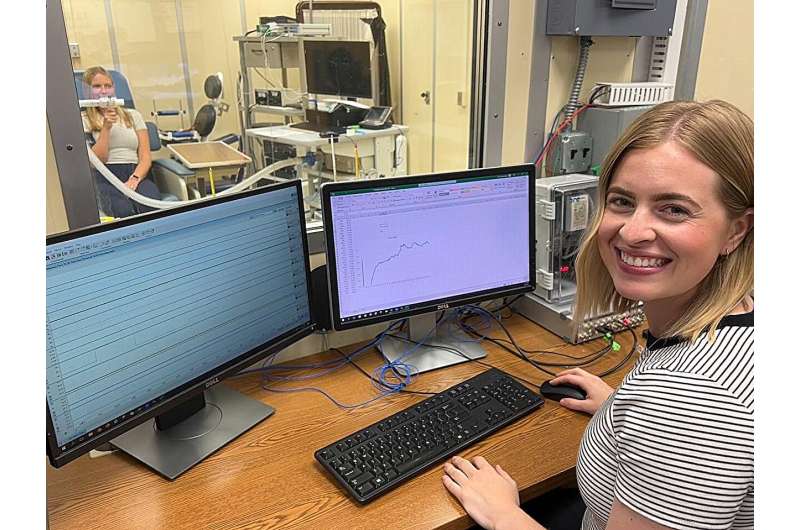This article has been reviewed according to Science X's editorial process and policies. Editors have highlighted the following attributes while ensuring the content's credibility:
fact-checked
trusted source
proofread
Older women more vulnerable to heat than their male peers, researchers find

As global climate change causes extreme heat waves to become more common around the world, epidemiological studies have shown that heat kills more women than men.
Now, a new study by researchers at Penn State has found that older women are physiologically more vulnerable to high heat and humidity than older men, and that women between the ages of 40 and 64 are as vulnerable as men 65 years of age or older.
This is the first study to determine that this disparity exists due to physiological differences and not because women live longer than men, which leaves a larger population of older women than older men.
Led by Olivia Leach, doctoral candidate in kinesiology at Penn State, and her adviser, W. Larry Kenney, professor of physiology and kinesiology, and the Marie Underhill Noll Chair in Human Performance at Penn State, the researchers demonstrated that middle-aged and older women were affected by heat at lower temperature/humidity combinations than middle-aged and older men.
The results, published in the American Journal of Physiology: Regulatory, Integrative and Comparative Physiology, were somewhat unexpected, according to Leach, because there are no differences in heat vulnerability based on biological sex in adults younger than 30.
While the researchers did not directly compare middle-aged men to middle-aged women, the physiological responses of middle-aged women were similar to the responses of older men in the study, which demonstrated that middle-aged women are more vulnerable to heat than men of the same age.
"In addition to demonstrating that middle-aged and older women are at greater risk from extreme heat, we also identified what levels of heat and humidity are safe for women as they age," Leach said. "This information is presented as a temperature/humidity curve based on a person's age, and it can be useful for setting policies designed to keep people safe during a heat wave."
The researchers tested the heat thresholds of 72 participants between 40 and 92 years of age in a specialized environmental chamber in Kenney's laboratory. Before the experiment, participants swallowed a tiny device encased in a capsule that measured their core temperature throughout the experiment.
During the study, participants entered the specialized environmental chamber where they performed light physical activity to simulate the effort of minimal day-to-day tasks—the types of things people would need to do even during a heat wave. The researchers then gradually increased the temperature and/or humidity in the chamber until the participant's body could no longer adequately cool itself, and their core temperature began to rise.
The study is part of the PSU H.E.A.T., or Human Environmental Age Thresholds, project, led by Kenney. For five years, researchers in the PSU H.E.A.T project have examined the levels of combined heat and humidity that humans can tolerate before their core temperatures begin to rise. When core temperatures rise, people become vulnerable to heat-related illnesses including heat exhaustion, heat stroke and even death.
"We're not saying that people who experience a certain temperature will necessarily become sick or die," Kenney said. "We are identifying the limits of livability—the thresholds where people can no longer continue their daily life unimpeded. Once people reach these temperatures, they need to take actions like seeking air conditioning to cool their bodies."
Previous research by Kenney and others demonstrated that people become increasingly vulnerable to heat as they age, because their ability to efficiently sweat and pump blood to the skin—two primary mechanisms for cooling themselves—decreases. Sweat evaporation carries heat away from the body, while extra blood pumped to the skin dissipates heat to the environment and supports sweating.
To date, the PSU H.E.A.T. project has conducted more than 600 experiments on nearly 200 participants between ages 18 and 92, but the results of this experiment still yielded surprises, according to Leach.
"Among young adults, there is no difference in heat vulnerability between men and women," Leach said. "Young people tend to be healthier, so any measurable health metric—from blood pressure to cholesterol—is more homogeneous among young people than it is among older people."
As with other health measures, older adults have a wide range in their vulnerability to heat, Leach explained.
"We have examined many factors that might explain who faces the most risk in a heat wave," Leach said. "We found that age and biological sex are the two most important factors that can predict whether a healthy adult would be at risk from high heat and humidity."
While cardiovascular health and certain medications can affect a person's sensitivity to heat, biological sex and age appear to be the two primary drivers of heat vulnerability among healthy people, the researchers said.
"Other factors—for example someone's cardiovascular fitness or their body mass—have little impact on how vulnerable a person is to heat at rest or during light activity," Leach continued. "Older women really are at greater risk from heat than other people. As governments and other social leaders prepare for extreme heat to become more common, the vulnerability of older women needs to factor into their planning."
More information: Olivia K. Leach et al, Sex differences in heat stress vulnerability among middle-aged and older adults (PSU HEAT Project), American Journal of Physiology: Regulatory, Integrative and Comparative Physiology (2024). DOI: 10.1152/ajpregu.00114.2024




















